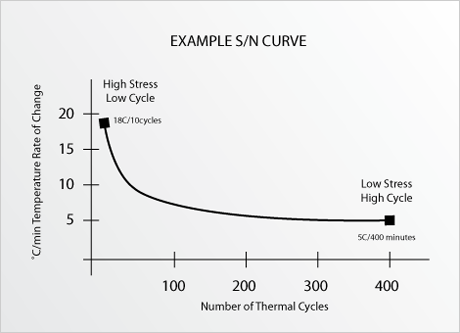Why HALT Works?
In order to verify designs, component specifications, and manufacturing processes, traditional new product verification testing approaches make no attempt to improve product robustness beyond operating specifications. But in today’s competitive marketplace, the design phase presents a perfect opportunity to test a product to find its maximum limitations. So, in contrast to traditional DVT (Design Verification Testing) which utilizes relatively low stresses and requires many cycles, the purpose of HALT (Highly Accelerated Life Test) is to find all possible failure modes - and it does so in far less time than ESS (Environmental Stress Screening), burn-in or other methods.
More stress or more time?
The power of HALT testing is derived from a simple basic principle – if you wish to fatigue a component, populated printed circuit board, subassembly or finished product you can stress it with lower levels of stress for a lot of cycles, or use a higher level of stress for a fewer number of cycles.

In this example of the S/N (Stress/Number) curve, an automotive electronic control system component required 400 cycles at low stress (5C/min) to replicate a field failure. This equates to 11 days of testing. By elevating the stress, in this case to 18C/min, the time to replicate the failure was shortened to a mere 110 minutes, requiring only 10 cycles. In prototype phase, HALT testing can significantly shorten design cycles - which gets products to market faster, with lower development costs and improved product yield.
The value of multiple axis
Every failure mode in a product has an axis associated with it. To ensure that failure modes don’t translate into latent flaws that will show up in the field, ESPEC HALT systems are engineered to deliver rigorous RS (Random Shock) vibration across 6 axes (X, Y, and Z simultaneous with pitch, roll, and yaw) around the orthogonal axis. This OmniAxial™, 6 DoF (Degree of Freedom) vibration is delivered in conjunction with thermal extremes and product specific stresses in order to fully test a product to its fundamental technological limit. In contrast, ED (ElectroDynamic) shakers, commonly used design verification tests, can only detect failures based on a single axis. HALT testing, therefore, results in better product performance data and increases the opportunity to improve product robustness by delivering unique, combined stress extremes not available with any other system. HALT provides a means of finding design flaws in a matter of hours or days that most traditional test methods would miss in months and months of testing.
In fact, results found in accelerated reliability testing labs clearly show that as many as 32% of failure modes would be missed without the combined stresses delivered with ESPEC technology, in spite of newer, more dependable design and manufacturing techniques.




 Find our Products by Region:
Find our Products by Region: